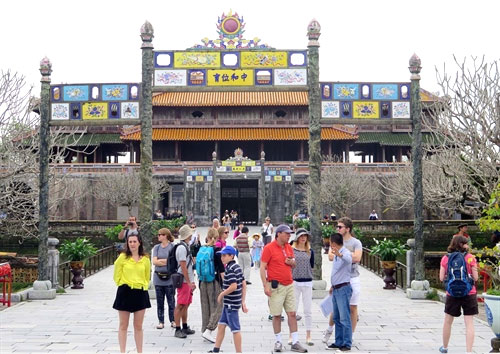France helps Vietnam preserve heritage
Nguyen Dung, vice chairman of the province’s People’s Committee, said that preservation and restoration of cultural heritage plays a critical role in improving tourism to the central province of Thua Thien–Hue.
However, time and urbanisation have seriously affected heritage buildings in the province as well as in Ha Noi and HCM City, he said.
 |
| Photo: VNA/VNS |
Established as the capital of a unified Viet Nam in 1802, Hue was the political, cultural and religious centre under the Nguyen Dynasty until 1945. Many of its palaces and pagodas remain, although some were bombed in the American War.
Dung spoke at a symposium that was part of the 10th Viet Nam–France cooperation conference held last week, attended by hundreds of experts from Nimes, France and Viet Nam, which focused on preservation of the Hue monuments.
Cao Chi Hai, deputy director of the province’s Department of Culture, Sports and Tourism, said that the public needed to be more aware of the importance of preservation of cultural heritage and its influence on tourism and the economy.
Representatives from the Interdepartmental Syndicate for Sanitation of Greater Paris are helping to upgrade the water drainage system in Hue.
France and Viet Nam are also developing ecotourism and heritage preservation projects in the province’s Bach Ma National Park.
France has also provided Ha Noi and HCM City with assistance in upgrading old apartment buildings.
Heritage management
Experts at the symposium said the complex of Hue monuments was in dire need of preservation and management by the Government.
The Hue Monuments Conservation Centre, which is overseen by the province, is responsible for the management and protection of the complex’s outstanding universal value, according to the UNESCO website.
The centre is guided by the 1972 Convention on the Protection of the World Cultural and Natural Heritage, the National Heritage Law (revised in 2009), and a number of other provincial regulations and decisions, according to the website.
With more than 700 employees from various professional backgrounds, the centre deals with all issues, including zoning, research, tangible and intangible heritage preservation, traditional material reproduction, and visitor management.
The centre is also responsible for planning and protection of the landscape in the buffer zone and in the surrounding area.
The province will provide direction for conservation and restoration of the complex through 2020.
Its master plan focuses on minimising the negative impact of noise and visual pollution on the Minh Mang and Khai Dinh tombs. Any illegally constructed buildings within the site will be removed.
Climate change and natural disasters are other problems facing the long-term management of the property.
The water network and drainage system in and around the citadel will be upgraded to lower the risk of floods at the World Heritage property, and to reconstitute the historic network of ponds and canals.
In a related issue, an international workshop was held recently in Thua Thien Hue Province to seek measures to promote cultural heritage values during the Nguyen Dynasty (1802-1945).
The event attracted more than 200 representatives from the Ministry of Culture, Sports and Tourism, Viet Nam Cultural Heritage Association, Viet Nam History of Science Association, Viet Nam National Museum of History, and representatives from South Korea, Japan, France and Germany.
The workshop focused on UNESCO-recognised heritage sites from Viet Nam’s last dynasty.

